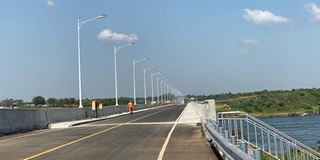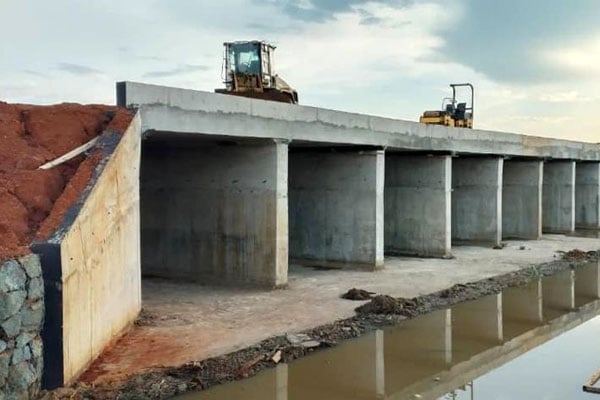Isimba bridge boosts trade in Busoga and Kayunga

A section of the Isimba Bridge which connects Kayunga to districts in Busoga Sub-region. Photo / Courtesy
What you need to know:
- However, the distance was reduced to 27 kilometres, which has boosted trade between Kayunga and Busoga Sub-region.
- Mr Andrew Muwonge, the Kayunga District chairperson, says traders and cattle keepers are the biggest beneficiaries of the project.
Before the newly-constructed Isimba bridge, it took travelers four hours from Kayunga to connect to Kamuli through Jinja, a journey of 115 kilometres.
However, the distance was reduced to 27 kilometres, which has boosted trade between Kayunga and Busoga Sub-region.
Mr Andrew Muwonge, the Kayunga District chairperson, says traders and cattle keepers are the biggest beneficiaries of the project.
“Although Kamuli and Buyende districts share a boundary, Kampala and Kayunga traders had to use a longer route via Jinja, which increased their operational costs,” Mr Muwonge says.
The districts of Kamuli, Buyende, Kaliro and Iganga are known for growing cereals and cattle rearing, while Kayunga and its neighbouring district of Mukono are known for pineapple, coffee and banana growing.
Mr Robert Mugiti, the chairperson of Pineapple and Watermelon Vendors’ Association in Kamuli District, says they were being delayed by the ferry, which often had to wait for hours to get filled up or sometimes developed mechanical problems.
He adds that the ferry was only operational during day time.
“So, the bridge is a great relief, people now travel any time they want,” Mr Mugiti says .
President Museveni commissioned the bridge in January 2021. It has two bridges with one measuring 433 metres and another 457.5 metres.
Both are 11.5 metres wide, each with two 1.5 metre walkways and two motor vehicle traffic lanes, making it the second longest bridge in the country after the source of the Nile Bridge in Jinja .
Mr Maxwell Mugudde Kuwembula, the Kamuli District chairperson, says the bridge has also reduced the distance between Kamuli and Kampala, adding that it takes less than an hour to travel from Kamuli via Kayunga to Kampala.
“Of course trade has been boosted, but above all, Kampala City has become a stone throw away from Kamuli, which was not the case before,” Mr Kuwembula says.
Mr Lawrence Pario, the Uganda National Roads Authority (Unra) head of bridges and structures, says: “The bridge has now completely changed the economy of that place, there are many shops, petrol stations, roadside fruit and food vendors.”
He also says the bridge has made it easier for traders to transport sugarcane from both regions at a low cost.
Mr David Mubialiwo, the Busaana Town council mayor, says the bridge created a highway through the district. “As Busaana Town Council, we have benefited from the construction of the bridge because we have begun getting some local revenue in form of parking fees for taxis and trucks; however, it is still little,” Mr Mubialiwo says.
He urged residents to create more businesses such as hotels, lodges and fruit stalls to increase their household income.
Mr Pario, however, notes that he was unaware how far plans by the Ministry of Tourism to transform the bridge into a tourism site had reached.
To increase accessibility, the government is tarmacking the Kayunga–Busaana road.
Tourism
The two sections of the bridge are joined by Kova Island. There are plans to restore the natural beauty of the island through tree growing.
Ms Lilly Ajarova, the chief executive officer of Uganda Tourism Board, said they would support Kayunga leaders once they submit their proposal to develop Kova Island into a tourism site.
“As a board, we don’t develop tourism sites, but we assist districts and other stakeholders to provide technical guidance to develop such sites.
Additional reporting by Wilson Kutamba




